A painter mixes paints on a palette to produce the right shade of blue for ocean waters. When I want to capture the multi-hued brown feathers of a shorebird like the one above, I blend dyed wool, spinning it into yarn.
What are the advantages of spinning my own yarn? First, a yarn spun from several hues is richer than a flat single solid color yarn. The feathers on Shorebird Peril are not just brown. They are rose, orange, chestnut, and gold.
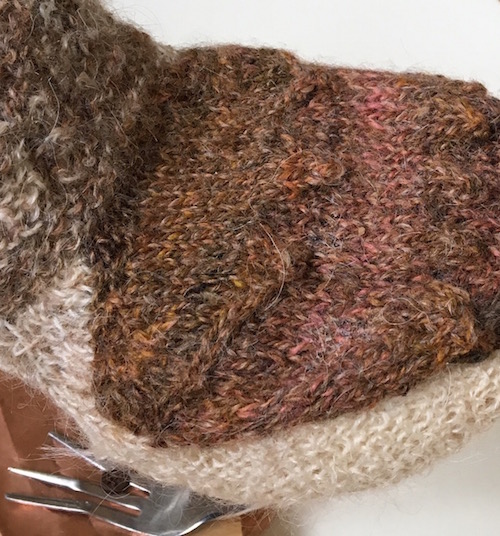
© 2016 Eve Jacobs-Carnahan, Shorebird Peril (detail).
The painter Vincent Van Gogh knew that placing bits of colors next to each other would create a rich impression. He studied Michel-Eugène Chevreul’s color theory. This French chemist explained the effects created when different colored strands of yarn were woven next to each other in tapestries. Van Gogh kept a box of yarns that he used to experiment with different color combinations.
Second, though commercial yarns come in hundreds of colors, they may not be available in the color and thickness that I need for a particular sculpture. When I spin my own yarn, I can determine the color and the thickness. It can be bulky or light, chunky or smooth. I am not subject to the style decisions of the yarn company’s designers.
Stacking batts of color
I start with dyed wool, sometimes mixed with silk or mohair to add shine to catch the light. For a blue-green yarn subtly streaked with yellow, I might choose wools in six hues ranging from yellow to green to blue.

Image 1. Six colors of roving.
Before I twist these fibers into yarn on my spinning wheel, I stack them in layers of fluffy carded batts. If I stack equally thick layers of different colors, the final yarn will have equal proportions of each color. If I substitute a striped batt, like the tri-colored one I am pulling off the drumcarder here, for one of the solid color layers, then this color will be less predominant.
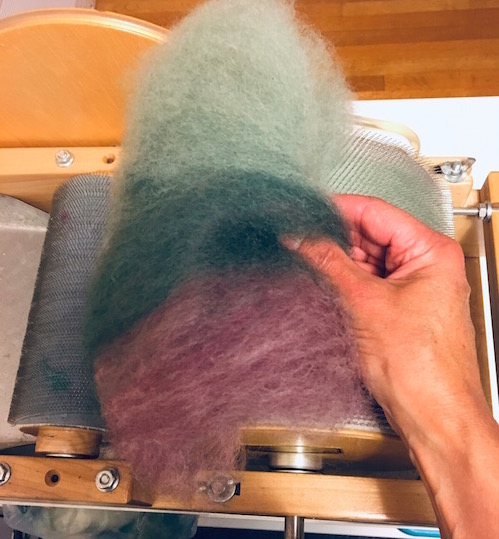
Image 2. Pulling striped batt off drumcarder.
Once all the colored batts are stacked in a pile, I roll them into a log. Viewed from the end, the colors will show up in repeating concentric circles of color, like the circles of cake and filling in a jelly roll.
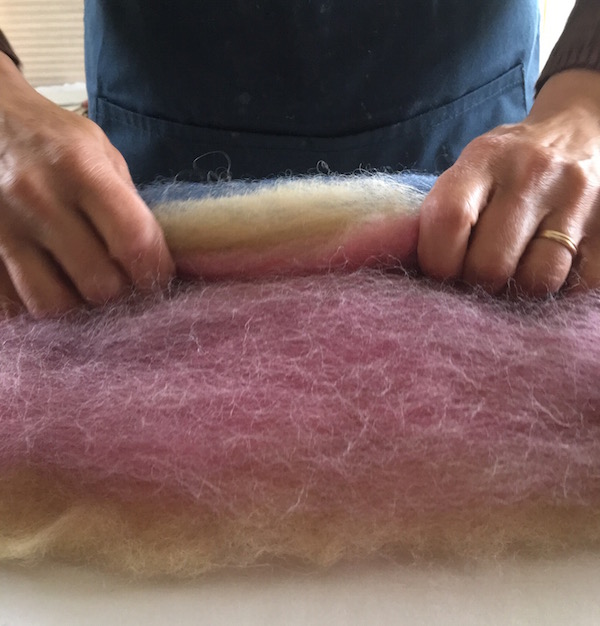
Rolling layered wool batt of blue, pale yellow, and rose.
This fat log is much too thick to spin, so I elongate it by pulling it gently into a roving. Here is a roving pulled from batts of cream, two shades of green, and two shades of blue wool.
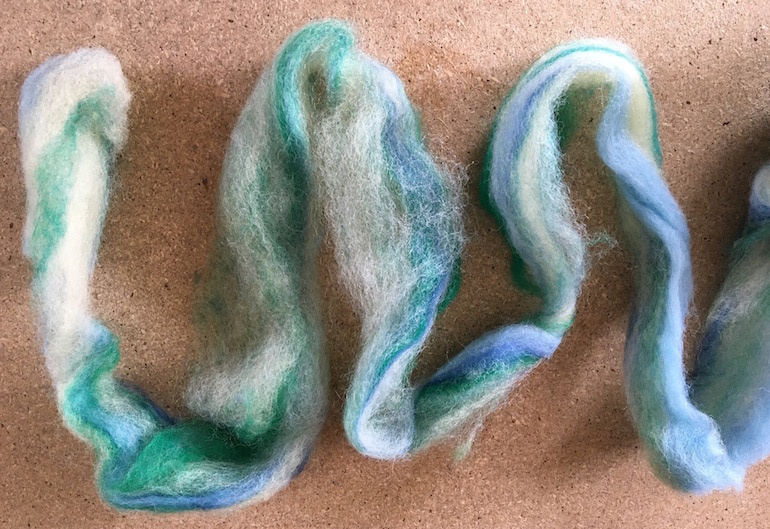
Adding more variation through spinning
At this stage, the roving is ready to be twisted into yarn on the spinning wheel. But there are more decisions to make. The yarn can be spun into a thick single strand, or into thin strands that are plied together. The thinner the yarn and the greater number of strands plied together, the more the colors will intertwine. As they intertwine optical blending makes them appear as new blurred colors.
Here is a bobbin showing a single strand of spun yarn. You can see how the stripes of green and red-violet in the roving become more subtle as they are thinned out in the yarn. This yarn was made from batts of green stacked with the striped batt from image 2 above.
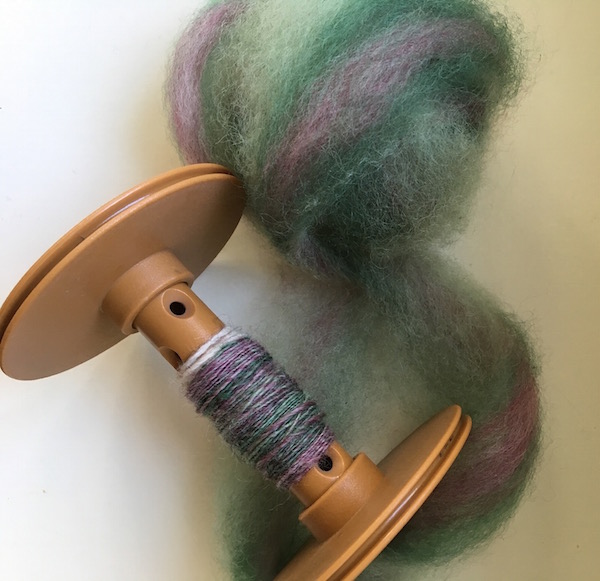
The only way to really know how the yarn will look once it is knitted is to knit a test swatch. Here is the yarn that I made from the six colors in image 1. I spun two bobbins from the same roving and then them together. The yellows, greens, and blues twisted with each other to create random combinations. Sometimes green twisted against green, sometimes it twisted against yellow or blue. The effect of this yarn is solid from a distance, but many colors up close.

The result is a richer color than the solid color commercial yarn shown next to it. Both yarns have their place, and by spinning my own, I can choose the one that best captures the mood or image I want.
For an excellent reference book with detailed guidance on combing colors in yarn, check out Color in Spinning by Deb Menz published by Interweave Press.
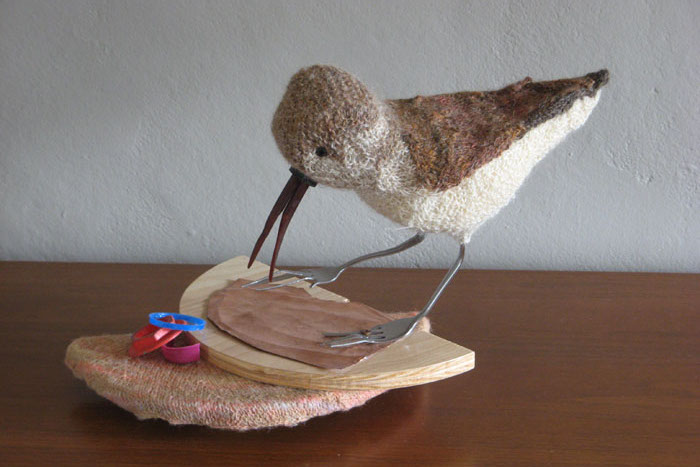
So interesting about Van Gogh. And, as you know, I love your work.
It’s so nice to have fans like you, Michele.
Ditto to all the other comments – plus very interesting to read about Van Gogh’s use of yarn for color selection!
I saw the red Chinese box that Van Gogh kept his yarn in at the exhibit Van Gogh Up Close at the Philadelphia Museum of Art. If you Google it you’ll find several articles about it.
Wow! where were you when I was making my Mushroom Quilt! I never thought of spinning my own yarns, and may have been a bit daunted by the prospect if I had. That said, the final yarn products would have been much more rich. Thank you for your detailed easily understood and illustrated blog. I had no idea you spun your yarns and am most impressed! The richness as well as the depth and play/interaction of color you create is fascinating and beautiful. In the future I’ll “see” your work with new eyes and better understanding of your process. Thanks so much for sharing with us!!
I could definitely see you being entranced choosing colors for yarn, Diane. I do use commercial yarns on occasion too.
Eve – a very interesting and well written blog, with great photos!
Thanks, Sally!
Eve, I loved reading about your process. I think it always adds to the enjoyment of the finished work to know the different steps that go into it. Spinning is something I’ve never tried, so I was especially happy to learn a bit about how you create your yarns. Talk about labor intensive!!!! Thank you!
Judy, it’s labor intensive but meditative too. On the other hand, the detailed stitching that you do would be difficult for me.